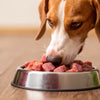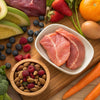Does Raw Dog Food Cause Gas? Understanding the Dietary Impact on Digestion
- Houndsy
Table of Contents
- Introduction
- Understanding Raw Dog Food Diets
- Do Raw Dog Foods Cause Gas?
- Managing Gas in Dogs on Raw Diets
- The Advantages of the Houndsy Kibble Dispenser
- Key Takeaways
- Conclusion
Introduction
Have you ever found yourself questioning why your beloved pup has a sudden bout of gas? It can be surprising, even alarming, when we hear those unexpected rumbles and smells. Flatulence is a common occurrence among dogs, but what role does diet play in this potentially embarrassing situation? One prevalent question heard among dog owners is: does raw dog food cause gas?
At Houndsy, we recognize the significant impact that a dog's diet can have—not only on their digestive health but also on the joy and satisfaction of pet ownership. In recent years, the trend of feeding raw dog food has gained popularity, driven by aspirations for whole, natural diets that many pet parents believe align more closely with their dogs’ ancestral eating habits. However, this shift raises valid concerns regarding digestive issues, especially gas production.
In this blog post, we will delve deep into the implications of a raw food diet and its possible connection to gas in dogs. We aim to equip you with insights to discern how raw diets work, why some dogs may experience increased gassiness, and how to enhance your furry friend’s feeding experience. Together, we'll explore best practices in maintaining your dog's optimal digestive health, emphasizing the value of products like the Houndsy Kibble Dispenser that simplify the dog-feeding experience while promoting health and wellbeing.
So, let's jump in! What exactly does feeding raw dog food mean for your pet, and how can it affect their gas production?
Understanding Raw Dog Food Diets
What is Raw Dog Food?
Raw dog food refers to an uncooked diet plan often composed of raw meat, organ meats, bones, fruits, and vegetables. This dietary practice, sometimes termed a raw meat-based diet (RMBD) or biologically appropriate raw food (BARF), seeks to mimic the diets of wild canines. Raw dog food has emerged as a compelling alternative to traditional kibbles, which are generally heavily processed.
The allure of raw diets can be found in the belief that these options offer a nutritious, unadulterated source of energy for dogs. Raw feeding enthusiasts advocate that natural diets lead to shinier coats, increased energy levels, improved dental health, and better overall digestion. As advocates for innovative design in pet care, we at Houndsy understand the appeal of simple yet effective solutions for pet owners striving to elevate their dogs' feeding practices.
Types of Raw Dog Food
Raw dog food can be categorized into three main types:
-
Homemade Raw Diets: Pet owners create these diets themselves, providing a mix of raw meat, bones, and suitable fruits and vegetables. This approach requires careful planning to ensure nutritional balance and safety.
-
Commercial Raw Diets: These include frozen, freeze-dried, or dehydrated raw dog foods that are pre-packaged for convenience, aiming to achieve a complete and balanced diet.
-
Mixed Raw Diets: This category includes raw components combined with high-quality dry or wet food, leveraging the benefits of both worlds.
Before making changes to your dog’s diet, it’s crucial to consult your veterinarian or a pet nutrition specialist to determine what works best for your furry friend.
Benefits of Raw Dog Food Diets
Many owners share their success stories regarding raw diets, reporting improvements in their dogs’ health. Some commonly cited benefits include:
- Food Sensitivity Improvement: Elimination of potential allergens like corn and wheat can benefit dogs with sensitivities or allergies.
- Improved Coat Health: Raw diets are rich in omega fatty acids, which can lead to a shinier coat and healthier skin.
- Enhanced Digestion: The absence of fillers often seen in processed foods can lead to better nutrient absorption.
Despite these potential benefits, raw diets come with notable risks and challenges that warrant careful consideration.
Do Raw Dog Foods Cause Gas?
The Connection Between Diet and Gas
The question of whether raw dog food causes gas is complex and often depends on various dietary factors. While a raw diet can improve some dogs’ digestion, it can also lead to increased gas for several reasons:
-
Changes in Gut Flora: Transitioning to a raw diet can lead to shifts in a dog’s gut microbiome. This shift may cause temporary gassiness as beneficial bacteria adjust to digesting new food types.
-
Fermentable Ingredients: Raw meats paired with high levels of fiber-rich ingredients—such as fruits and vegetables—can create gas during digestion. Ingredients like peas, lentils, or beans may contribute to excess gas production as they ferment in the gut.
-
Swallowing Air: Dogs that consume their food quickly (common with raw diets when pets are excited) can gulp air, leading to the development of gas.
-
Individual Digestive Sensitivities: Just like humans, individual dogs have unique digestive systems. Factors such as age, breed, and pre-existing conditions may predispose some dogs to greater gas production when on raw diets.
The Role of Raw Diet Composition
While raw dog food appears more natural, it’s essential to consider its total composition. Diets high in difficult-to-digest components (e.g., certain fibrous vegetables) may lead to gastrointestinal distress, while proteins from handling raw meat could provoke reactions if improperly balanced.
A well-balanced raw diet should be composed carefully, focusing on the appropriate ratio of meat, bones, organs, and vegetables. This balance is critical to supporting healthy digestion and minimizing the risk of discomfort.
What the Research Tells Us
Recent studies have indicated that transitioning to raw dog food can lead to both positive and negative gastrointestinal changes. Research published in peer-reviewed veterinary journals highlights that while some dogs may thrive on raw diets, others experience digestive disturbances, including excessive gas. Thus, it’s crucial to listen to your dog’s individual response to dietary changes and adjust accordingly.
Managing Gas in Dogs on Raw Diets
If you notice that your dog is experiencing increased gas with a raw diet, several strategies can help manage and mitigate the issue. Here are actionable approaches:
Transition Gradually
Rather than an abrupt switch to raw food, we recommend a gradual transition over 7 to 10 days. Start by mixing small portions of raw food with your dog’s existing diet, slowly increasing raw content while monitoring for digestive improvements or distress.
Choose Digestible Ingredients
When incorporating fruits and vegetables, focus on those well known for being gentle on canine digestions, such as mashed pumpkin, sweet potatoes, or cooked carrots. These options provide fiber without excessive fermentability.
Address Feeding Style
Consider using a slow feeder bowl to promote mindful eating habits, allowing your dog to take their time while eating and reducing air intake. Additionally, dividing meals into two or three smaller portions can aid in digestibility.
Monitor Their Reaction
Pay close attention to any shifts in digestion and overall health. Regular observations of your dog’s stool, energy levels, and appetite can provide critical insights. If significant gas persists or is accompanied by other symptoms, consult your veterinarian.
The Advantages of the Houndsy Kibble Dispenser
At Houndsy, our commitment to elevating the pet feeding experience is reflected in our innovative Houndsy Kibble Dispenser. This thoughtfully designed product addresses several challenges faced by pet owners:
- Perfect Portion Control: With every crank, you dispense the right amount, reducing overeating and gulping—two contributors to excess gas.
- Ergonomic Design: Standing height eliminates the need for bending, providing comfort and ease for both owner and dog during feeding time.
- Elegant Aesthetics: Our mid-century modern design beautifully complements your home decor while serving as a functional tool in your pet care routine.
As we strive to enhance your dog’s feeding experience, we invite you to explore the Houndsy Kibble Dispenser and consider how it can be integrated into your routine. Order now!
Key Takeaways
So, does raw dog food cause gas? The answer is nuanced and depends significantly on the individual dog and the specific composition of their raw diet. While some dogs may thrive and experience no gas issues, others could be sensitive to certain ingredients or the abrupt dietary change.
Pet owners should carefully navigate raw dog diets, paying attention to their pet's unique responses and remaining vigilant for any digestive issues. Incorporating practical feeding practices, using quality feeders like the Houndsy Kibble Dispenser, and consulting with veterinary professionals can support better gut health for your furry companion.
Conclusion
Navigating the world of dog food can seem overwhelming, especially with trends around raw diets making headlines. In our quest to do what’s best for our pets, understanding how diet influences their health—especially concerning gas—empowers us to make informed choices.
At Houndsy, we’re invested in not only enhancing the dining experience but also ensuring the wellbeing of your beloved dogs. With thoughtful design combined with our commitment to quality, we believe you can elevate the feeding ritual and positively impact your dog's health and happiness.
We encourage you to reflect on your dog’s feeding habits and consider the role of diet in their life. What changes can you implement today for a healthier tomorrow?
FAQ
1. Why does my dog have gas after eating raw food?
Gas can be a result of dietary ingredients and the transition to new foods. Ingredients such as high-fiber vegetables can ferment in the gut, leading to gas. Monitor your dog's response to different foods and adjust as needed.
2. Should I switch to a raw diet if my dog has gas?
Not necessarily. If your dog experiences frequent gas, consult your veterinarian before switching diets. They can provide guidance tailored to your dog's specific needs.
3. Can dietary changes reduce gas production?
Yes! Gradually introducing a balanced diet, minimizing gas-producing ingredients, and using appropriate feeding techniques can significantly impact gas reduction.
4. Is Houndsy Kibble Dispenser suitable for other types of dog food?
Absolutely! The Houndsy Kibble Dispenser is versatile and can accommodate dry kibble, providing the same benefits in portion control and ease of use, regardless of the food type.
5. How can I tell if my dog’s diet is affecting their health?
Observing changes in your dog's energy levels, stool quality, and overall behavior can indicate how their diet is affecting them. Persistent issues should be discussed with a veterinarian for thorough evaluation.
We hope this article has shed light on the relationship between raw dog food and gas, and equipped you with knowledge to make the best decisions for your furry friend’s health and happiness.













